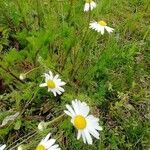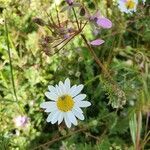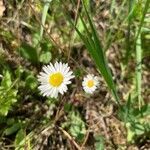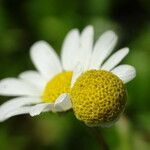Annuals (sometimes persisting), (5–)10–30+[–80] cm, not notably scented. Stems green or reddish, decumbent (sometimes rooting at nodes) or ascending to erect, branched mostly proximally, ± strigoso-sericeous or villous, glabrescent. Leaf blades 15–35 × 8–16 mm, 1–2-pinnately lobed (ultimate lobes triangular to narrowly elliptic or linear). Peduncles mostly 4–15 cm (sometimes clavate in fruit). Involucres 6–13 mm diam., ± villous. Receptacles paleate throughout; paleae lanceolate to oblanceolate, weakly navicular (± carinate), 3–4+ mm (including acuminate-spinose tips). Ray florets 5–20, pistillate, fertile; corollas white, rarely tinged with pink, laminae 5–15 mm. Disc corollas (sometimes tinged with purple) 2–3(–4) mm. Cypselae 1.7–2+ mm, ribs smooth or weakly tuberculate (sometimes separated by relatively deep furrows); pappi 0 or coroniform (0.01+ mm). 2n = 18.
Annual herb to c. 60 cm high, hardly odorous when crushed, sparsely to moderately hairy. Leaves to c. 5 cm long, sub-2 to 3-pinnatisect. Capitulum (15–) 20–35 mm diam.; peduncle with largely appressed hairs distally at anthesis, ±sericeous when dense; involucre 4–6.5 mm long, hairy; inner bracts with hyaline extension 1–2 mm long; paleae associated with all disc florets, narrowly elliptic, to 0.5–1 mm wide. Ray florets 15–20, female, fertile; ligule 8–16 mm long, white. Disc floret corolla 2.5–3 mm long, swollen at base. Achenes of disc florets obovoid, c. 2 mm long, commonly c. 1 mm diam., sometimes c. 2 mm diam., slightly 4-angled, smooth along ribs. Pappus absent or a vestigial ring.
Similar to no. 3 [Anthemis cotula L.], commonly a little more hairy, and not ill-scented; lvs appearing a little less finely dissected; heads averaging a little larger; rays pistillate and fertile; receptacle chaffy throughout, its bracts softer, paleaceous, with short, cuspidate awn-tip; achenes not tuberculate; 2n=18. Fields and waste places; native of Europe, naturalized over most of the U.S., and widespread in our range. May–Aug.
A herb.










